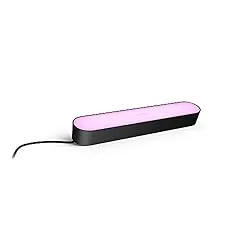Nanoleaf: Panels vs Canvas vs Shapes [+ Comparison Chart]
Nanoleaf make some excellent smart LED panels that add ambiance to any room and are particularly popular with gamers thanks to the ability to create an immersive gaming experience.
However, Nanoleaf haven’t made it very easy to understand the different features, so that’s why I’ve created this guide.
If you need a quick answer: Nanoleaf Shapes are the best for hexagonal or triangle shapes and Nanoleaf Canvas are best for Squares. I would avoid Nanoleaf Light Panels as these have less features but cost a similar amount.
Table Of Contents
- Product Comparison Table
- What is Nanoleaf?
- What Are the Similarities Between All Nanoleaf?
- What Are The Differences Between Nanoleaf Lights?
- Nanoleaf Shapes vs Light Panels
- What’s the Difference Between Nanoleaf Smarter Kit and Starter Kit?
- What is Nanoleaf Rhythm?
- What is Nanoleaf Essentials?
- Are Nanoleaf Worth it?
- Are There Cheaper Alternatives to Nanoleaf?
Quick Summary
| Image | Summary | |
|---|---|---|
BEST SQUARES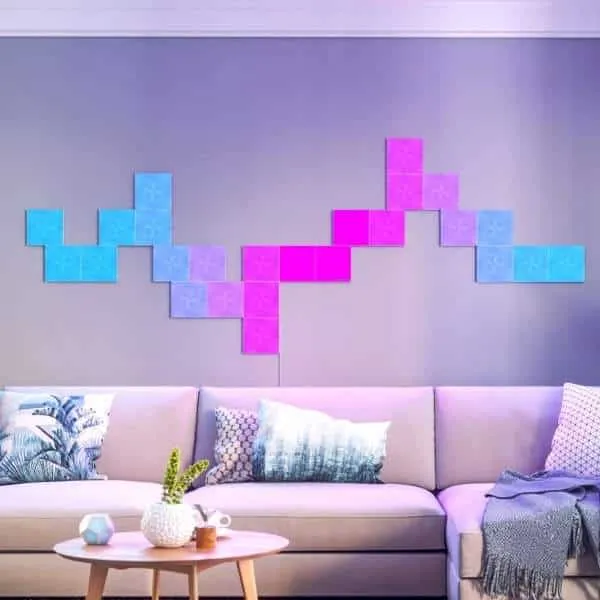 | Nanoleaf Canvas • Square only. • Cannot be used with other Nanoleaf products. • Touch contol • Sync to music | View on Nanoleaf |
BEST FOR SHAPES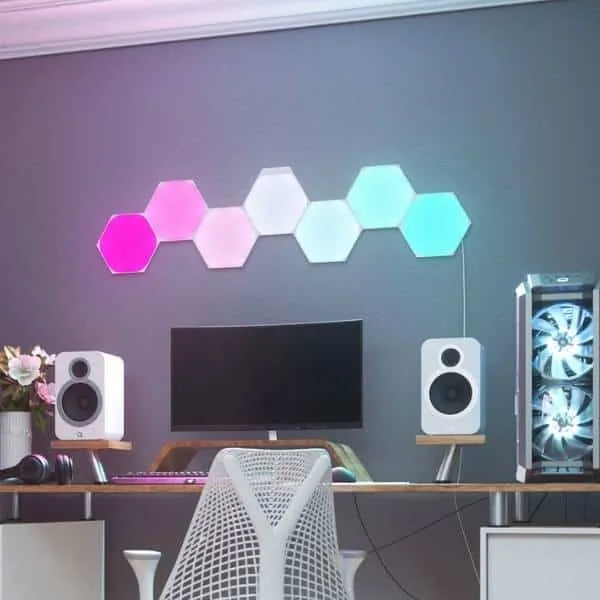 | Nanoleaf Shapes • Available as triangle, mini-triangle and hexagonal. • All shapes can be connected together, but cannot be used with other Nanoleaf products. • Touch control • Sync to music | View on Nanoleaf |
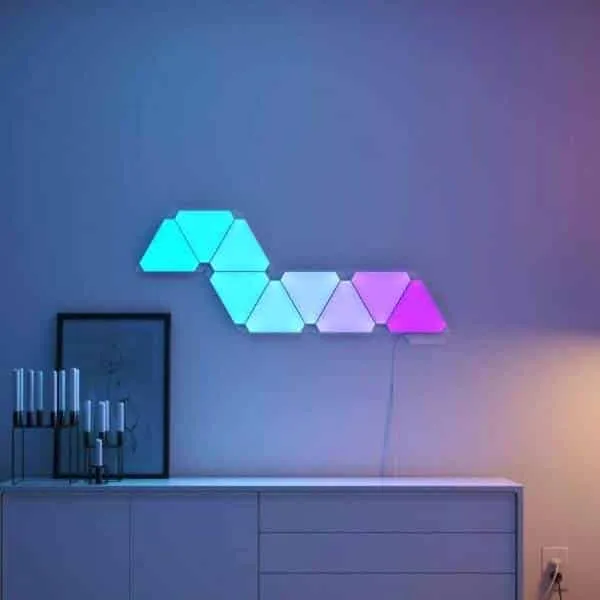 | Nanoleaf Light Panels • Triangles only • No touch control • Cannot be used with other Nanoleaf products. • Fewer buttons on the device • Sync to music | View on Nanoleaf |
Product Comparison Table
[table id=13 /]
Note: I’ve not included the new Nanoleaf Essentials Light bulbs and light strips int his table, but there are more details on these later on.

What is Nanoleaf?
Nanoleaf is a brand that is primarily known for it’s Nanoleaf light panels.
These are modular LED panels that come in a variety of geometric shapes and can be connected together to create customised light displays.
As with many smart lights, the products have WiFi which allows them to be controlled via an app or using a voice assistant such as Google Home and Alexa.
They are very common for gamers and with owners of Apple devices thanks to their flawless HomeKit integration.
What Are the Similarities Between All Nanoleaf?
There are three main types of product; Nanoleaf Shape (hexagonal and triangle), Nanoleaf Canvas (square) and Nanoleaf Light Panels (triangle).
Besides the obvious shape differences, there are other variations in the features which I’ll delve in to.
Before jumping into the differences between each Nanoleaf product, here are the similarities:
Colours and light effects
All of the Nanoleaf products have the full spectrum of 16 million colours and white light temperature between 1200K-6500K.
The lighting effects can be set up in the app where you can choose scenes or customise each panel one-by-one.
Similar to Philips Hue, Nanoleaf is also open to third party apps which opens the door to even better effects. Popular third-party apps include Firestorm, Thunderstorm and Firefly which have custom scenes.
Sync to music
All Nanoleaf products now have the rhythm module built-in, allowing you to sync the lights to music via the built-in microphone or aux cable.
If you have the third-party app iLightShow, you can sync the lights to your Spotify app rather than using the onboard lighting module.
Screen mirror
Using the Nanoleaf desktop app, you can set up your Nanoleaf lights to mirror the lighting on the screen.
This creates an immersive experience which is very popular with gamers.
Voice assistant integration
All of the Nanoleaf products integrate with Google Home, Alexa and HomeKit for voice control.
Nanoleaf also works with IFTTT if you want to get more granular with your integrations.
What Are The Differences Between Nanoleaf Lights?
Here are the key differences between Nanoleaf Shapes, Canvas and Light Panels (previously Aurora):
Touch control
Only Nanoleaf Shapes and Nanoleaf Canvas have touch control. This allows Touch Gestures and Touch Actions:
- Touch Gestures – You can swipe up, down, left and right to control your lights
- Touch Actions – Assign smart home actions to each individual panel to control other HomeKit devices using tap, double tap and triple tap.
Connect+
Only Nanoleaf Shapes have connect+ built in. This allows you to connect the hexagons, triangles and mini-triangles together.
Nanoleaf Canvas and Nanoleaf Light Panels do not have this feature and can only be expanded with the same panels.
Buttons on the lights
There are slightly different manual controls on Nanoleaf Light Panels which do not have buttons for ‘scene shuffle’ or ‘rhythm on/off’.
Nanoleaf Shapes vs Light Panels
Both the Shapes and Light Panels are available in triangles, so what’s the difference?
Nanoleaf Light Panels are far more basic than Nanoleaf Shapes as they do not have touch control or the connect+ module which allows you to connect different shapes to create more customised designs.
There are also fewer manual controls on the Light Panels with no ‘shuffle scenes’ or ‘rhythm on/off’ buttons.
Most of the other features are similar for Shapes and Light Panels, including music sync, Screen Mirror and integrations with voice assistants such as Alexa and Google Home.
Overall, Nanoleaf Shapes are the best Nanoleaf products.
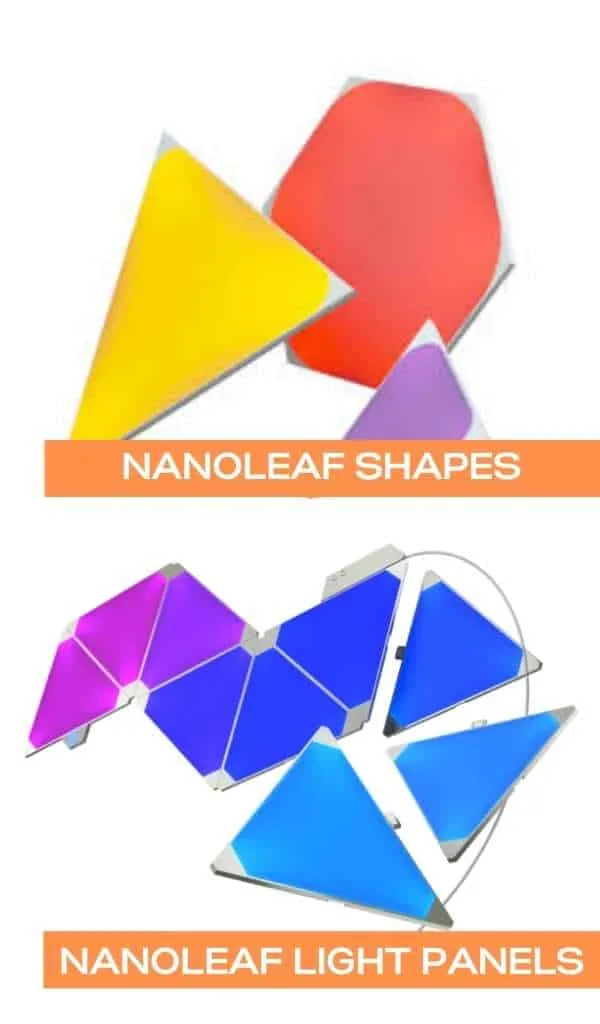
What’s the Difference Between Nanoleaf Smarter Kit and Starter Kit?
There are two types of Nanoleaf product: a starter kit and an expansion pack.
The starter kit contains the control module and power adapter, whereas the expansion pack is extra light panels to add on to an existing set up.
A starter kit is sometimes referred to as a smarter kit, these are the same thing. Smarter kit was an old term that Nanoleaf used but some retailers still have this on product listings.
What is Nanoleaf Rhythm?
Nanoleaf Rhythm is the module that allows Nanoleaf lights to sync with music using a built-in microphone.
Previously, there were Rhythm and non-Rhythm versions of products, or you could purchase the Rhythm module separately.
However, the latest generation all come with Rhythm built-in so there is no need to worry about this.
What is Nanoleaf Essentials?
Nanoleaf Essentials is a range of more basic smart lighting. This includes a standard smart light and smart light strip.
They are notable as some of the first smart lights to use the Thread wireless protocol which is an equivalent to Zigbee or Bluetooth.
This means they integrate really well with Apple HomePod and are future proof for when the new protocol becomes widely adopted. There is also Bluetooth LE built in for the mean time.
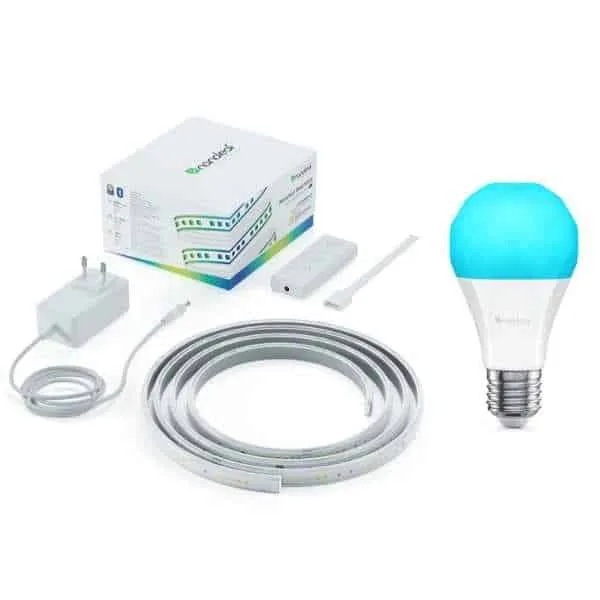
Are Nanoleaf Worth it?
There’s no denying that all Nanoleaf products are quite expensive, even for smart lights.
However, the functionality is far above any similar products and once they have been set up, Nanoleaf are generally very reliable.
If you are planning to glam up your home with some smart LED panels then Nanoleaf are worth the extra cost and with a lifetime of 25,000 hours, they will last for many years without needing to be replaced.
Overall, I’d say that Nanoleaf are worth the cost if you can afford to splash out.
Are There Cheaper Alternatives to Nanoleaf?
Yes, there are cheaper alternatives to Nanoleaf, however they don’t have as many features and are usually a lot smaller in size.
The best alternative is Cololight, these are also smart and have similar light effects.
However, they are about half the size of Nanoleaf, so you’ll need to purchase more panels to get the same level of lighting.
Another recommended alternative is Phillips Hue Play Bar.
Whilst this is not an LED wall panel like Nanoleaf, it does perform a similar function of lighting up a wall with colour.
These are much cheaper and can also be synced with music or integrated with a gaming monitor.
